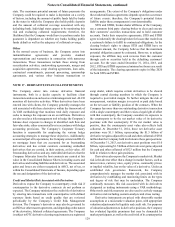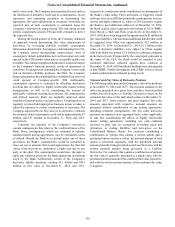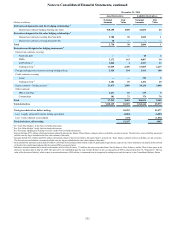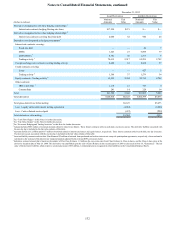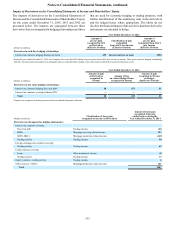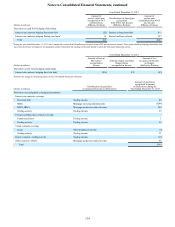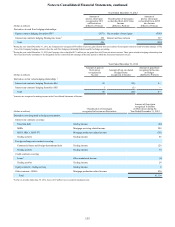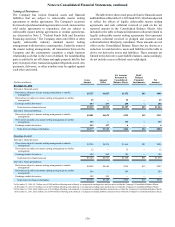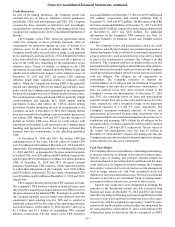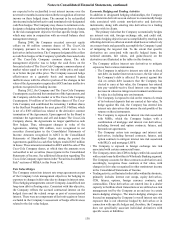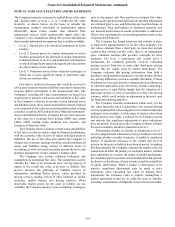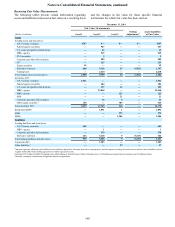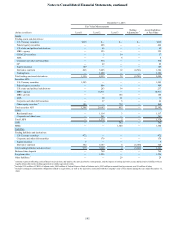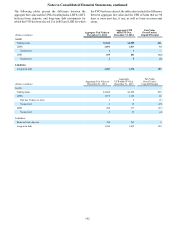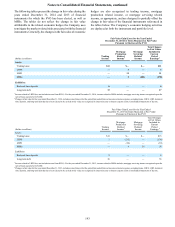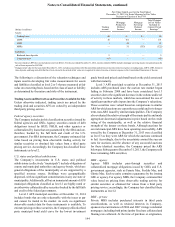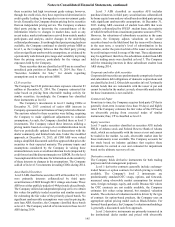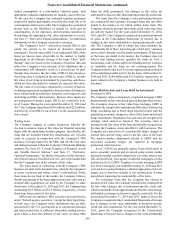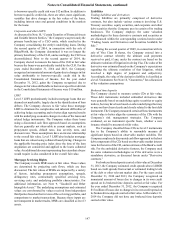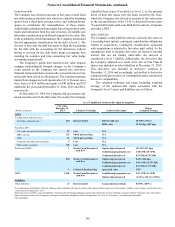SunTrust 2014 Annual Report Download - page 161
Download and view the complete annual report
Please find page 161 of the 2014 SunTrust annual report below. You can navigate through the pages in the report by either clicking on the pages listed below, or by using the keyword search tool below to find specific information within the annual report.
Notes to Consolidated Financial Statements, continued
138
are expected to be reclassified to net interest income over the
next twelve months in connection with the recognition of interest
income on these hedged items. The amount to be reclassified
into income includes both active and terminated or de-designated
cash flow hedges. The Company may choose to terminate or de-
designate a hedging relationship in this program due to a change
in the risk management objective for that specific hedge item,
which may arise in conjunction with an overall balance sheet
management strategy.
During 2008, the Company executed zero-cost equity
collars on 60 million common shares of The Coca-Cola
Company pursuant to the Agreements, which were to be
derivatives in their entirety. The Company designated the collars
as cash flow hedges of the Company's probable forecasted sales
of The Coca-Cola Company common shares. The risk
management objective was to hedge the cash flows on the
forecasted sales of The Coca-Cola Company common shares at
market values equal to or above the call strike price and equal
to or below the put strike price. The Company assessed hedge
effectiveness on a quarterly basis and measured hedge
ineffectiveness with the effective portion of the changes in fair
value of the Agreements recognized in AOCI and any ineffective
portions recognized in trading income.
During 2012, the Company and The Coca-Cola Company
Counterparty accelerated the termination of the Agreements, and
the Company sold in the market or to The Coca-Cola Company
Counterparty 59 million of its 60 million shares of The Coca-
Cola Company and contributed the remaining 1 million shares
to the SunTrust Foundation for a net gain of $1.9 billion, which
is net of a $305 million loss related to the derivative contract
termination of the Agreements. Upon approval by the Board to
terminate the Agreements and sell and donate The Coca-Cola
Company shares, the Agreements no longer qualified as cash
flow hedges. Thus, subsequent changes in value of the
Agreements, totaling $60 million, were recognized in net
securities (losses)/gains in the Consolidated Statements of
Income. Amounts recognized in AOCI in the Consolidated
Statements of Shareholders' Equity during the period the
Agreements qualified as cash flow hedges totaled $365 million
in losses. These amounts remained in AOCI until the sale of The
Coca-Cola Company shares, at which time the amounts were
reclassified to net securities (losses)/gains in the Consolidated
Statements of Income. See additional discussion regarding The
Coca-Cola Company Agreements in the "Securities Available for
Sale" sections of MD&A in this Form 10-K.
Fair Value Hedges
The Company enters into interest rate swap agreements as part
of the Company’s risk management objectives for hedging its
exposure to changes in fair value due to changes in interest rates.
These hedging arrangements convert Company-issued fixed rate
long-term debt to floating rates. Consistent with this objective,
the Company reflects the accrued contractual interest on the
hedged item and the related swaps as part of current period
interest. There were no components of derivative gains or losses
excluded in the Company’s assessment of hedge effectiveness
related to the fair value hedges.
Economic Hedging and Trading Activities
In addition to designated hedging relationships, the Company
also enters into derivatives as an end user to economically hedge
risks associated with certain non-derivative and derivative
instruments, along with entering into derivatives in a trading
capacity with its clients.
The primary risks that the Company economically hedges
are interest rate risk, foreign exchange risk, and credit risk.
Economic hedging objectives are accomplished by entering into
offsetting derivatives either on an individual basis or collectively
on a macro basis and generally accomplish the Company’s goal
of mitigating the targeted risk. To the extent that specific
derivatives are associated with specific hedged items, the
notional amounts, fair values, and gains/(losses) on the
derivatives are illustrated in the tables in this footnote.
• The Company utilizes interest rate derivatives to mitigate
exposures from various instruments.
The Company is subject to interest rate risk on its fixed
rate debt. As market interest rates move, the fair value of
the Company’s debt is affected. To protect against this
risk on certain debt issuances that the Company has
elected to carry at fair value, the Company has entered
into pay variable-receive fixed interest rate swaps that
decrease in value in a rising rate environment and increase
in value in a declining rate environment.
The Company is exposed to risk on the returns of certain
of its brokered deposits that are carried at fair value. To
hedge against this risk, the Company has entered into
interest rate derivatives that mirror the risk profile of the
returns on these instruments.
The Company is exposed to interest rate risk associated
with MSRs, which the Company hedges with a
combination of mortgage and interest rate derivatives,
including forward and option contracts, futures, and
forward rate agreements.
The Company enters into mortgage and interest rate
derivatives, including forward contracts, futures, and
option contracts to mitigate interest rate risk associated
with IRLCs and mortgage LHFS.
• The Company is exposed to foreign exchange rate risk
associated with certain commercial loans.
• The Company enters into CDS to hedge credit risk associated
with certain loans held within its Wholesale Banking segment.
The Company accounts for these contracts as derivatives and,
accordingly, recognizes these contracts at fair value, with
changes in fair value recognized in other noninterest income
in the Consolidated Statements of Income.
• Trading activity, as illustrated in the tables within this footnote,
primarily includes interest rate swaps, equity derivatives,
CDS, futures, options, foreign currency contracts, and
commodities. These derivatives are entered into in a dealer
capacity to facilitate client transactions or are utilized as a risk
management tool by the Company as an end user in certain
macro-hedging strategies. The macro-hedging strategies are
focused on managing the Company’s overall interest rate risk
exposure that is not otherwise hedged by derivatives or in
connection with specific hedges and, therefore, the Company
does not specifically associate individual derivatives with
specific assets or liabilities.



